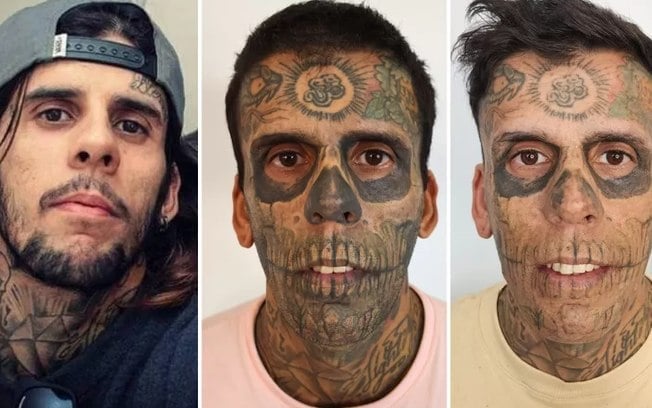Photographer Leandro de Souza, 35, is known as the “most tattooed man in Brazil”. He dedicated 20 years of his life to tattoos and has now converted to the gospel. Because of this, he began to remove all the paints that cover his body and face.
Leandro gained popularity on social media by sharing his journey of personal transformation, including overcoming drug addiction and the process of removing the tattoos that reflect his past. He published videos showing parts of the laser sessions to remove the skull tattoo on his face, revealing the intermediate results.
The photographer says that, after becoming an evangelical a year and seven months ago, he stopped “overnight” consuming drugs, drinks and cigarettes. According to Leandro, he was “reached by the removal of the tattoos”, when he won free treatment from a clinic, after a testimony that went viral, asking for a job.
He explains that his passion for tattoos arose from the desire to be noticed and admired, as they ensured that he was the center of attention wherever he went. “However, over time, I realized that I was more like a circus attraction. I didn’t want this life for myself anymore.”
Although the process of removing tattoos is painful, Leandro sees it as an opportunity to express his regret and seek a new phase in his life.
“It hurts a lot, no matter how much they put anesthesia, the pain is horrible. But that’s part of the price of the things I’ve done in the past. I am confident because the clinic team is excellent and the results have been satisfactory,” Leandro tells UOL.
So far, Leandro has undergone two laser removal sessions. However, he estimates that he will need about eight additional sessions every three months over a two-year period to eliminate all tattoos. This is due to the fact that 95% of his body is covered in tattoos, which earned him an award at an international event last year.
Leandro started his journey with tattoos as a teenager, getting his first tattoo, which honored a rock band, at the age of 13, with his mother’s permission. As time went on, he developed a real appreciation for the art and eventually specialized as a tattoo artist.
“I worked for many years as a tattoo artist, while continuing to fill my body with tattoos. I was even named the most tattooed man in Brazil at the Santa Rosa International Tattoo Expo in 2023. I did it out of total idolatry. I idolized artists of the world and had a life of sex, drugs and rock’n’roll before Christ,” Leandro told UOL.
Tattoo removal
The laser process is considered the safest and most efficient method for removing tattoos.
The laser works by fragmenting the tattoo pigment, allowing the body to gradually eliminate it through natural processes such as urine and sweat.
Leandro’s tattoos, especially because they are on his face and are colorful, present a considerable challenge. The removal of pigments around the eyes is particularly complicated, requiring special care to avoid complications.
The cost of removal ranges from R$ 150 per session for small tattoos, such as a letter on the finger. However, colored tattoos are more difficult to remove and require advanced technologies, making the process more expensive.
Despite the good results after two sessions, the biomedical doctor cannot predict the total number of sessions needed. Sessions are scheduled at intervals of 60 to 90 days to allow the skin to recover and the body to eliminate pigments.
Pain sensitivity can vary, but it is controlled with local anesthetic and cooling during the procedure. Post-session care includes ice packs, repairing creams and avoiding sun exposure.
For the removal of Leandro’s tattoos, the professional is using a combination of different types of lasers to treat the pigment and rejuvenate the skin. One of the lasers used is PicoSure, which is the first to emit extremely short pulses of energy, in picoseconds.
In addition, other technologies are employed, such as fractional ablative lasers and q-switched lasers. Fractional ablative lasers act on the surface of the skin, creating micro-lesions that stimulate an inflammatory response and the production of new collagen. Q-switched lasers, on the other hand, emit intermittent beams and pulses, allowing energy to be better focused and light more efficient.
Want to stay on top of the main news of the day? Click here and be part of our WhatsApp channel.


